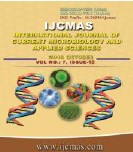


 National Academy of Agricultural Sciences (NAAS)
National Academy of Agricultural Sciences (NAAS)

|
PRINT ISSN : 2319-7692
Online ISSN : 2319-7706 Issues : 12 per year Publisher : Excellent Publishers Email : editorijcmas@gmail.com / submit@ijcmas.com Editor-in-chief: Dr.M.Prakash Index Copernicus ICV 2018: 95.39 NAAS RATING 2020: 5.38 |
All over the world, Infectious bronchitis (IB) is one of the most fearful diseases of the poultry industry causing significant economic loses. The present study was aimed at the isolation, identification and molecular characterisation of IBV isolates. For the present study, samples were collected from chicken of different age groups that have shown signs of respiratory tract infection. The specific UP and DOWN primers targeting the highly conserved region of 5’UTR were used for the detection of IBV and the positive samples were selected for further characterization. The hypervariable region of spike gene was amplified by RT-PCR and sequenced to study the genetic diversity between the isolated viruses. All samples were also inoculated onto nine to eleven day old specific pathogen free embryonated chicken eggs via, allantoic cavity. After harvesting, allantoic fluid was collected and RT-PCR was conducted for confirmation. Phylogenetic tree was constructed with the help of MEGA 7 software using maximum likelihood method by including bootstrap values for analysing the evolutionary pattern of IBV isolates. Out of the 20 samples collected, seven were positive for IBV using specific UP and DOWN primers. Virus inoculated embryos after seventh blind passage showed curling and dwarfing, which is the characteristic lesion of IBV. The hyper variable region of spike gene of all the positive isolates were amplified by RT-PCR and sequenced to study the genetic diversity of the isolated viruses. The sequences of the isolates were found to have identity with each other, and with the sequences of commercial vaccine strains available in NCBI GenBank database, slight variations were detected. Phylogenetic tree revealed that IBV isolates obtained in our study were similar to the isolates from various other countries including Indian isolates. It is necessary to study the genetic variation in the IBV isolated from particular geographical areas, which in turn could help us in developing an area specific vaccination programme to combat the disease.
 |
 |
 |
 |
 |